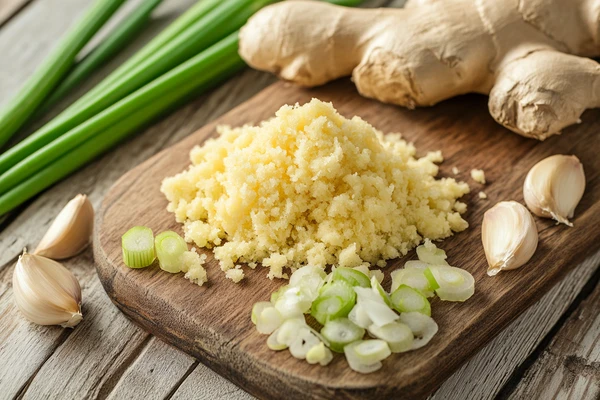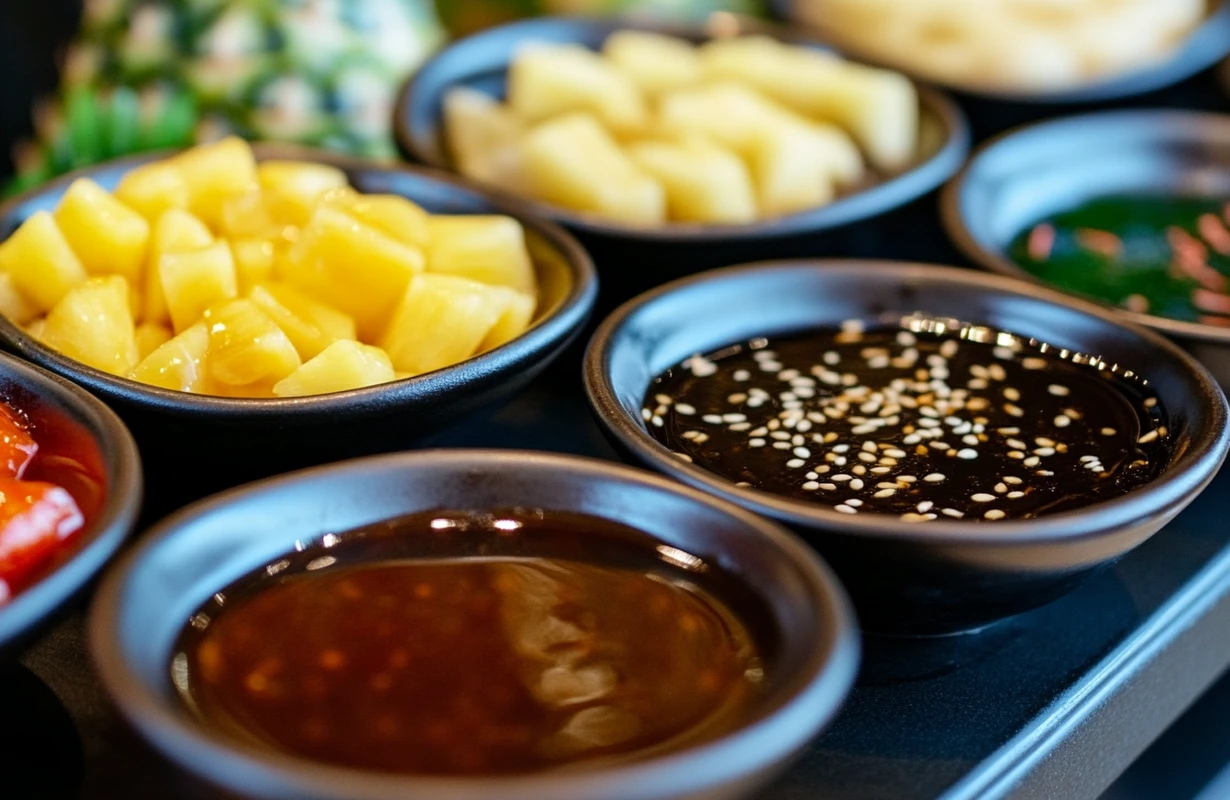Teriyaki sauce is a beloved condiment with a rich, glossy texture and a perfect blend of sweet and savory flavors. Whether drizzled over grilled meats or used as a marinade, this versatile sauce is a favorite in kitchens worldwide. But have you ever asked yourself, what is teriyaki sauce made of?
Introduction
Teriyaki sauce is a staple in Japanese cuisine, known for its perfect balance of sweet and savory flavors. This glossy, rich sauce has gained global popularity for its versatility in enhancing the taste of meats, vegetables, and even seafood.
But have you ever wondered, what is teriyaki sauce made of? In this article, we’ll break down the core ingredients, show you how to make it at home, and share tips for using it in your favorite dishes.
Core Ingredients of Teriyaki Sauce
To create the iconic flavor of teriyaki sauce, chefs use a handful of simple yet essential ingredients. Each one contributes to the sauce’s balance of sweetness, saltiness, and depth.
1. Soy Sauce
Soy sauce serves as the base of teriyaki sauce, providing its deep umami flavor and signature saltiness. Choose light or dark soy sauce depending on your flavor preference.
2. Sugar or Sweetener
Chefs add sugar or other sweeteners like honey or brown sugar to balance the saltiness of soy sauce. This sweetness gives teriyaki sauce its caramelized glaze when cooked.
3. Mirin
Mirin, a sweet Japanese rice wine, adds both sweetness and a subtle tang. It enhances the glossy texture of the sauce while deepening its flavor.
4. Sake (Optional)
Some recipes include sake, a Japanese rice wine, for an additional layer of flavor and aroma. This ingredient complements the other elements and adds complexity to the sauce.
5. Ginger and Garlic
Freshly minced ginger and garlic bring a bold, aromatic quality to teriyaki sauce. These ingredients elevate the flavor, making the sauce versatile and dynamic.
6. Cornstarch Slurry (Optional)
To thicken teriyaki sauce, mix a little cornstarch with water and add it to the simmering sauce. This step ensures a glossy, syrupy consistency perfect for coating dishes.
These core ingredients define the unique taste and texture of teriyaki sauce. Their simple combination allows for endless versatility in the kitchen.
Steps to Make Teriyaki Sauce

Creating teriyaki sauce at home is quick and simple. By combining a few basic ingredients, you can make a flavorful sauce that’s perfect for marinades, stir-fries, or glazes. Follow these steps:
Ingredients You’ll Need:
- 1/2 cup soy sauce
- 1/4 cup brown sugar (or honey)
- 1/4 cup mirin (or rice vinegar for substitution)
- 1 tablespoon sake (optional)
- 1 teaspoon freshly grated ginger
- 1 clove garlic, minced
- 1 teaspoon cornstarch mixed with 1 tablespoon water (optional, for thickening)
Steps to Make Teriyaki Sauce:
- Combine the Base Ingredients
In a small saucepan, mix soy sauce, brown sugar, mirin, and sake (if using). Stir until the sugar dissolves completely. - Add Aromatics
Add freshly grated ginger and minced garlic to the saucepan. These ingredients will infuse the sauce with bold, aromatic flavors. - Heat the Sauce
Place the saucepan over medium heat and bring the mixture to a gentle simmer. Stir occasionally to ensure the flavors meld together. - Thicken the Sauce (Optional)
If you prefer a thicker sauce, slowly stir in the cornstarch slurry while the sauce simmers. Continue stirring until the sauce reaches your desired consistency. - Taste and Adjust
Taste the sauce and adjust the sweetness or saltiness to your liking. Add a touch more sugar or soy sauce if needed. - Cool and Store
Remove the sauce from heat and let it cool to room temperature. Transfer it to an airtight container and store it in the refrigerator for up to one week.
With these simple steps, you can enjoy homemade teriyaki sauce that’s fresh, flavorful, and free from preservatives.
Nutritional Value
Understanding the nutritional content of teriyaki sauce can help you incorporate it into your meals while staying mindful of your dietary needs. Here’s a breakdown of the approximate nutritional values in one tablespoon (15g) of homemade teriyaki sauce:
| Nutrient | Amount per Serving (1 tbsp) | Details |
|---|---|---|
| Calories | 16 | Low in calories, making it a light condiment. |
| Carbohydrates | 3g | Primarily from sugar or sweeteners. |
| Protein | 0.5g | Derived from soy sauce. |
| Fat | 0g | Typically fat-free unless sesame oil is added. |
| Sodium | 600mg | High in sodium due to soy sauce; opt for low-sodium soy sauce if needed. |
| Sugar | 2g | Comes from added sugar, honey, or mirin. |
Note:
The nutritional values may vary based on the specific recipe and ingredients used. Adjust the sweetness or saltiness to suit your preferences or dietary requirements.
Variations and Add-Ons
While the classic teriyaki sauce recipe is delicious on its own, you can customize it to suit your taste or add depth to your dishes. Here are some popular variations and add-ons to experiment with:
1. Spicy Teriyaki Sauce
Add a kick to your sauce by stirring in chili flakes, sriracha, or a pinch of cayenne pepper. This variation pairs perfectly with grilled meats or stir-fried vegetables.
2. Pineapple Teriyaki Sauce
For a tropical twist, replace some of the liquid with pineapple juice. The natural sweetness and acidity of the juice enhance the flavor and make it ideal for glazing seafood.
3. Sesame Teriyaki Sauce
Sprinkle toasted sesame seeds into the sauce or drizzle in a teaspoon of sesame oil for a nutty, aromatic variation. This option is great for noodle dishes or rice bowls.
4. Citrus-Infused Teriyaki Sauce
Add a splash of orange or lime juice to brighten up the sauce. This version complements lighter proteins like chicken or tofu beautifully.
5. Smoky Teriyaki Sauce
Incorporate a touch of liquid smoke or smoked paprika for a deep, smoky flavor. This variation works wonderfully with grilled or roasted dishes.
6. Low-Sodium Teriyaki Sauce
Substitute low-sodium soy sauce to reduce the salt content without sacrificing flavor. Add a bit of honey or more ginger to enhance the taste.
These variations allow you to adapt teriyaki sauce to your preferences or the dish you’re preparing. Whether you want it sweet, spicy, or smoky, the possibilities are endless.
Common Uses for Teriyaki Sauce
Teriyaki sauce is incredibly versatile and can enhance a variety of dishes with its sweet and savory flavor. Here are some of the most popular ways to use it in your cooking:
1. Marinades
Use teriyaki sauce to marinate proteins like chicken, beef, pork, or tofu. The sauce tenderizes the meat while infusing it with rich flavors. Let the protein soak in the marinade for at least 30 minutes or overnight for the best results.
2. Glazes
Brush teriyaki sauce over grilled or roasted dishes as a glaze. Its glossy texture caramelizes beautifully, creating a sweet and savory crust on meats, fish, or vegetables.
3. Stir-Fries
Add teriyaki sauce to stir-fried dishes for an instant burst of flavor. It pairs well with mixed vegetables, noodles, or rice, making it a go-to option for quick weeknight meals.
4. Dipping Sauce
Serve teriyaki sauce as a dipping sauce for dumplings, spring rolls, or even sushi. You can thicken the sauce slightly to make it easier to dip.
5. Rice and Grain Bowls
Drizzle teriyaki sauce over rice or quinoa bowls topped with vegetables, proteins, and garnishes. This quick addition ties all the flavors together.
6. Burgers and Sandwiches
Use teriyaki sauce as a condiment for burgers or sandwiches. Spread it on buns or use it as a drizzle for grilled chicken or veggie patties.
Tips for Perfect Sauce
Creating a flavorful sauce is easy when you keep a few key tips in mind. These tricks will help you achieve the perfect balance of flavors and texture every time:
1. Balance Sweetness and Saltiness
Adjust the ratio of soy sauce to sugar or sweetener to suit your taste. If the sauce feels too salty, add a bit more sugar or a splash of water to mellow it out.
2. Use Fresh Ingredients
Incorporate fresh ginger and garlic for a bold, aromatic flavor. Grating ginger and mincing garlic finely ensures they blend smoothly into the sauce.
3. Simmer for Flavor
Simmer the sauce gently over low to medium heat to let the flavors meld together. Avoid boiling, as it can cause the sugar to caramelize too quickly.
4. Adjust Thickness
If you prefer a thicker sauce, use a cornstarch slurry (1 teaspoon cornstarch mixed with 1 tablespoon water). Stir it in gradually while the sauce simmers, and keep an eye on the consistency.
5. Experiment with Additions
Customize the sauce by adding a splash of fruit juice, sesame oil, or chili flakes. Small adjustments can elevate the flavor to match your dish.
6. Store Properly
Let the sauce cool completely before transferring it to an airtight container. Refrigerate for up to a week and stir before using, as some ingredients may settle.
Health Benefits of Teriyaki Sauce Ingredients
While teriyaki sauce is primarily known for its flavor, some of its ingredients also offer health benefits:
- Soy Sauce: Rich in umami, it contains small amounts of antioxidants and can enhance the taste of meals with minimal calories.
- Ginger: Known for its anti-inflammatory and digestive properties, ginger adds both flavor and health benefits.
- Garlic: Packed with antioxidants, garlic supports immune health and adds a robust depth to the sauce.
- Honey (if used): A natural sweetener that provides small amounts of vitamins and minerals along with a touch of sweetness.
By using fresh, quality ingredients, you can enjoy a flavorful sauce that complements your dishes while offering subtle health perks.
FAQs
Here are answers to some of the most common questions about this popular sauce:
1. Is teriyaki sauce only used for Japanese dishes?
No, while it originates from Japan, teriyaki sauce is widely used in a variety of cuisines, including fusion dishes and Western-style recipes.
2. Can I make it gluten-free?
Yes! Substitute regular soy sauce with gluten-free tamari or coconut aminos. Make sure other ingredients, such as mirin or sake, are also labeled gluten-free.
3. How can I store leftover sauce?
Store the sauce in an airtight container in the refrigerator. It keeps well for up to one week.
4. What protein pairs best with this sauce?
Teriyaki sauce complements proteins like chicken, beef, salmon, and tofu. Its sweet and savory flavor enhances both grilled and stir-fried options.
5. Can I use the sauce as a dipping option?
Absolutely! Serve it as a dipping sauce for dishes like sushi, dumplings, or spring rolls. Adjust the thickness if needed by simmering it longer or adding a cornstarch slurry.
6. Is it possible to make a sugar-free version?
Yes, replace sugar with a natural sweetener like stevia, monk fruit, or erythritol to create a sugar-free version while maintaining sweetness.
Conclusion
Teriyaki sauce is a versatile and flavorful addition to countless dishes. Whether you’re using it as a marinade, glaze, or stir-fry enhancer, its unique blend of sweet and savory flavors elevates any meal. With simple ingredients like soy sauce, sugar, and ginger, you can easily create this sauce at home and customize it to your liking.
For more teriyaki-inspired dishes, check out this recipe for Beef Teriyaki Bowls. It’s a perfect example of how teriyaki sauce can transform a simple dinner into a flavorful feast.
Experiment with your own variations of this classic sauce and enjoy the endless possibilities it brings to your meals! Let me know if you’d like to explore more recipe ideas.

